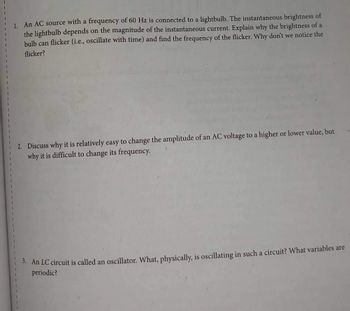
College Physics
11th Edition
ISBN: 9781305952300
Author: Raymond A. Serway, Chris Vuille
Publisher: Cengage Learning
expand_more
expand_more
format_list_bulleted
Question

Transcribed Image Text:1. An AC source with a frequency of 60 Hz is connected to a lightbulb. The instantaneous brightness of
the lightbulb depends on the magnitude of the instantaneous current. Explain why the brightness of a
bulb can flicker (i.e., oscillate with time) and find the frequency of the flicker. Why don't we notice the
flicker?
2. Discuss why it is relatively easy to change the amplitude of an AC voltage to a higher or lower value, but
why it is difficult to change its frequency.
3. An LC circuit is called an oscillator. What, physically, is oscillating in such a circuit? What variables are
periodic?
Expert Solution
This question has been solved!
Explore an expertly crafted, step-by-step solution for a thorough understanding of key concepts.
This is a popular solution
Trending nowThis is a popular solution!
Step by stepSolved in 5 steps

Knowledge Booster
Learn more about
Need a deep-dive on the concept behind this application? Look no further. Learn more about this topic, physics and related others by exploring similar questions and additional content below.Similar questions
- 15. A sinusoidal a.c. supply of frequency 200 Hz and peak voltage 24 V is applied to a pure capacitor is 4.4 uF, what is the rms value of the current in the circuit? A. 3.4 mA C. 67 mA B. 21 mA D. 94 mA 16. A capacitor is connected to an alternating voltage. The current in the circuit varies with time as shown in the graph. Current S Timearrow_forwardQ11. Please look at the circuit diagram given, the switch is originally kept at point a for a long time, then the switch is quickly flipped to point b.it is your job to determine the following. a. the frequency of current oscillations in the LC circuit. b. the current amplitude of the oscillations which result. 30.0 V 15.0 5.80 μF ele 48.0 mHarrow_forwardA series circuit has a sinusoidal voltage supplied to it at 632 kHz with a peak voltage of 748 V. It also contains a 25 kilo-Ohm resistance, a 16 microFarad capacitance, and a 30-H inductance. What is the peak current for this circuit? A. 11 micro Amps B. 20 micro Amps C. 6.3 micro Amps D. 26 micro Ampsarrow_forward
- The capacitor in the circuit shown is fully charged by a 24 V battery. The switch is closed at t = 0. At sometime after the switch is closed, the voltage across the capacitor is measured to be 10 V. What is the current in the circuit at this time, in Ampere? C = 3.0 µF, and R = 2.0 02. Your answer needs to have 2 significant figures, including the negative sign in your answer if needed. Do not include the positive sign if the answer is positive. No unit is needed in your answer, it is already given in the question statement. Cilarrow_forwardH1arrow_forwardIf an AC source has instantaneous voltage given as V(t) 13v Sin(120Tt) is connected to 6.5 Q resistor, then the value of the maxi current is, Select one: O a. 13 A O b. 84.5 A O c. 0.5 A O d. 2 A Next page cess Exam File Upload - Final Jump to... Exam Caid Aharrow_forward
arrow_back_ios
arrow_forward_ios
Recommended textbooks for you
 College PhysicsPhysicsISBN:9781305952300Author:Raymond A. Serway, Chris VuillePublisher:Cengage Learning
College PhysicsPhysicsISBN:9781305952300Author:Raymond A. Serway, Chris VuillePublisher:Cengage Learning University Physics (14th Edition)PhysicsISBN:9780133969290Author:Hugh D. Young, Roger A. FreedmanPublisher:PEARSON
University Physics (14th Edition)PhysicsISBN:9780133969290Author:Hugh D. Young, Roger A. FreedmanPublisher:PEARSON Introduction To Quantum MechanicsPhysicsISBN:9781107189638Author:Griffiths, David J., Schroeter, Darrell F.Publisher:Cambridge University Press
Introduction To Quantum MechanicsPhysicsISBN:9781107189638Author:Griffiths, David J., Schroeter, Darrell F.Publisher:Cambridge University Press Physics for Scientists and EngineersPhysicsISBN:9781337553278Author:Raymond A. Serway, John W. JewettPublisher:Cengage Learning
Physics for Scientists and EngineersPhysicsISBN:9781337553278Author:Raymond A. Serway, John W. JewettPublisher:Cengage Learning Lecture- Tutorials for Introductory AstronomyPhysicsISBN:9780321820464Author:Edward E. Prather, Tim P. Slater, Jeff P. Adams, Gina BrissendenPublisher:Addison-Wesley
Lecture- Tutorials for Introductory AstronomyPhysicsISBN:9780321820464Author:Edward E. Prather, Tim P. Slater, Jeff P. Adams, Gina BrissendenPublisher:Addison-Wesley College Physics: A Strategic Approach (4th Editio...PhysicsISBN:9780134609034Author:Randall D. Knight (Professor Emeritus), Brian Jones, Stuart FieldPublisher:PEARSON
College Physics: A Strategic Approach (4th Editio...PhysicsISBN:9780134609034Author:Randall D. Knight (Professor Emeritus), Brian Jones, Stuart FieldPublisher:PEARSON

College Physics
Physics
ISBN:9781305952300
Author:Raymond A. Serway, Chris Vuille
Publisher:Cengage Learning

University Physics (14th Edition)
Physics
ISBN:9780133969290
Author:Hugh D. Young, Roger A. Freedman
Publisher:PEARSON

Introduction To Quantum Mechanics
Physics
ISBN:9781107189638
Author:Griffiths, David J., Schroeter, Darrell F.
Publisher:Cambridge University Press

Physics for Scientists and Engineers
Physics
ISBN:9781337553278
Author:Raymond A. Serway, John W. Jewett
Publisher:Cengage Learning

Lecture- Tutorials for Introductory Astronomy
Physics
ISBN:9780321820464
Author:Edward E. Prather, Tim P. Slater, Jeff P. Adams, Gina Brissenden
Publisher:Addison-Wesley

College Physics: A Strategic Approach (4th Editio...
Physics
ISBN:9780134609034
Author:Randall D. Knight (Professor Emeritus), Brian Jones, Stuart Field
Publisher:PEARSON